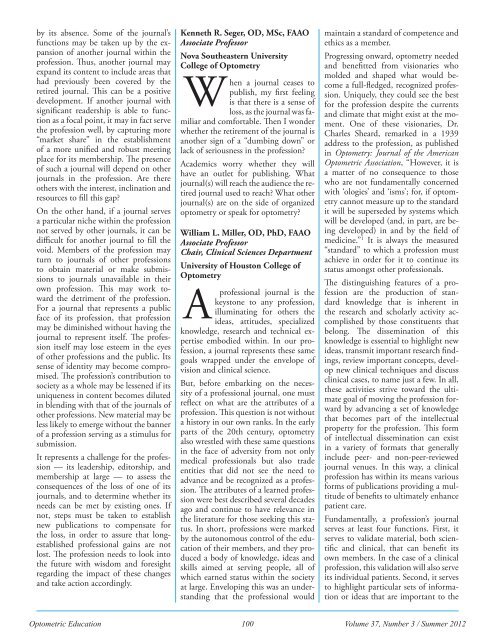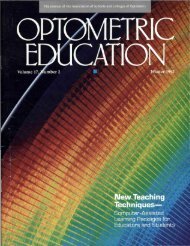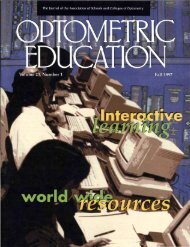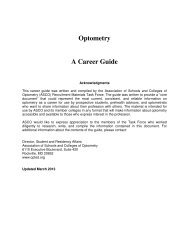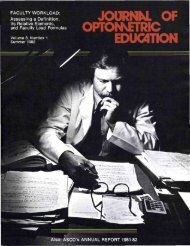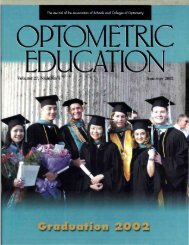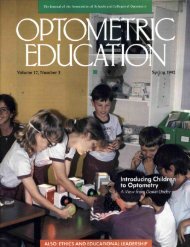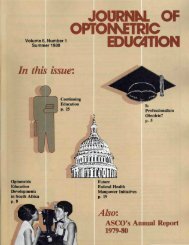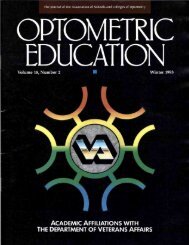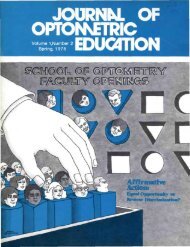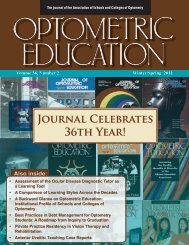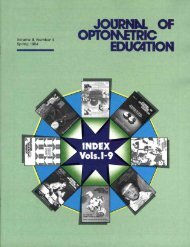Summer 2012, Volume 37, Number 3 - Association of Schools and ...
Summer 2012, Volume 37, Number 3 - Association of Schools and ...
Summer 2012, Volume 37, Number 3 - Association of Schools and ...
You also want an ePaper? Increase the reach of your titles
YUMPU automatically turns print PDFs into web optimized ePapers that Google loves.
y its absence. Some <strong>of</strong> the journal’s<br />
functions may be taken up by the expansion<br />
<strong>of</strong> another journal within the<br />
pr<strong>of</strong>ession. Thus, another journal may<br />
exp<strong>and</strong> its content to include areas that<br />
had previously been covered by the<br />
retired journal. This can be a positive<br />
development. If another journal with<br />
significant readership is able to function<br />
as a focal point, it may in fact serve<br />
the pr<strong>of</strong>ession well, by capturing more<br />
“market share” in the establishment<br />
<strong>of</strong> a more unified <strong>and</strong> robust meeting<br />
place for its membership. The presence<br />
<strong>of</strong> such a journal will depend on other<br />
journals in the pr<strong>of</strong>ession. Are there<br />
others with the interest, inclination <strong>and</strong><br />
resources to fill this gap?<br />
On the other h<strong>and</strong>, if a journal serves<br />
a particular niche within the pr<strong>of</strong>ession<br />
not served by other journals, it can be<br />
difficult for another journal to fill the<br />
void. Members <strong>of</strong> the pr<strong>of</strong>ession may<br />
turn to journals <strong>of</strong> other pr<strong>of</strong>essions<br />
to obtain material or make submissions<br />
to journals unavailable in their<br />
own pr<strong>of</strong>ession. This may work toward<br />
the detriment <strong>of</strong> the pr<strong>of</strong>ession.<br />
For a journal that represents a public<br />
face <strong>of</strong> its pr<strong>of</strong>ession, that pr<strong>of</strong>ession<br />
may be diminished without having the<br />
journal to represent itself. The pr<strong>of</strong>ession<br />
itself may lose esteem in the eyes<br />
<strong>of</strong> other pr<strong>of</strong>essions <strong>and</strong> the public. Its<br />
sense <strong>of</strong> identity may become compromised.<br />
The pr<strong>of</strong>ession’s contribution to<br />
society as a whole may be lessened if its<br />
uniqueness in content becomes diluted<br />
in blending with that <strong>of</strong> the journals <strong>of</strong><br />
other pr<strong>of</strong>essions. New material may be<br />
less likely to emerge without the banner<br />
<strong>of</strong> a pr<strong>of</strong>ession serving as a stimulus for<br />
submission.<br />
It represents a challenge for the pr<strong>of</strong>ession<br />
— its leadership, editorship, <strong>and</strong><br />
membership at large — to assess the<br />
consequences <strong>of</strong> the loss <strong>of</strong> one <strong>of</strong> its<br />
journals, <strong>and</strong> to determine whether its<br />
needs can be met by existing ones. If<br />
not, steps must be taken to establish<br />
new publications to compensate for<br />
the loss, in order to assure that longestablished<br />
pr<strong>of</strong>essional gains are not<br />
lost. The pr<strong>of</strong>ession needs to look into<br />
the future with wisdom <strong>and</strong> foresight<br />
regarding the impact <strong>of</strong> these changes<br />
<strong>and</strong> take action accordingly.<br />
Kenneth R. Seger, OD, MSc, FAAO<br />
Associate Pr<strong>of</strong>essor<br />
Nova Southeastern University<br />
College <strong>of</strong> Optometry<br />
When a journal ceases to<br />
publish, my first feeling<br />
is that there is a sense <strong>of</strong><br />
loss, as the journal was familiar<br />
<strong>and</strong> comfortable. Then I wonder<br />
whether the retirement <strong>of</strong> the journal is<br />
another sign <strong>of</strong> a “dumbing down” or<br />
lack <strong>of</strong> seriousness in the pr<strong>of</strong>ession?<br />
Academics worry whether they will<br />
have an outlet for publishing. What<br />
journal(s) will reach the audience the retired<br />
journal used to reach? What other<br />
journal(s) are on the side <strong>of</strong> organized<br />
optometry or speak for optometry?<br />
William L. Miller, OD, PhD, FAAO<br />
Associate Pr<strong>of</strong>essor<br />
Chair, Clinical Sciences Department<br />
University <strong>of</strong> Houston College <strong>of</strong><br />
Optometry<br />
A<br />
pr<strong>of</strong>essional journal is the<br />
keystone to any pr<strong>of</strong>ession,<br />
illuminating for others the<br />
ideas, attitudes, specialized<br />
knowledge, research <strong>and</strong> technical expertise<br />
embodied within. In our pr<strong>of</strong>ession,<br />
a journal represents these same<br />
goals wrapped under the envelope <strong>of</strong><br />
vision <strong>and</strong> clinical science.<br />
But, before embarking on the necessity<br />
<strong>of</strong> a pr<strong>of</strong>essional journal, one must<br />
reflect on what are the attributes <strong>of</strong> a<br />
pr<strong>of</strong>ession. This question is not without<br />
a history in our own ranks. In the early<br />
parts <strong>of</strong> the 20th century, optometry<br />
also wrestled with these same questions<br />
in the face <strong>of</strong> adversity from not only<br />
medical pr<strong>of</strong>essionals but also trade<br />
entities that did not see the need to<br />
advance <strong>and</strong> be recognized as a pr<strong>of</strong>ession.<br />
The attributes <strong>of</strong> a learned pr<strong>of</strong>ession<br />
were best described several decades<br />
ago <strong>and</strong> continue to have relevance in<br />
the literature for those seeking this status.<br />
In short, pr<strong>of</strong>essions were marked<br />
by the autonomous control <strong>of</strong> the education<br />
<strong>of</strong> their members, <strong>and</strong> they produced<br />
a body <strong>of</strong> knowledge, ideas <strong>and</strong><br />
skills aimed at serving people, all <strong>of</strong><br />
which earned status within the society<br />
at large. Enveloping this was an underst<strong>and</strong>ing<br />
that the pr<strong>of</strong>essional would<br />
maintain a st<strong>and</strong>ard <strong>of</strong> competence <strong>and</strong><br />
ethics as a member.<br />
Progressing onward, optometry needed<br />
<strong>and</strong> benefitted from visionaries who<br />
molded <strong>and</strong> shaped what would become<br />
a full-fledged, recognized pr<strong>of</strong>ession.<br />
Uniquely, they could see the best<br />
for the pr<strong>of</strong>ession despite the currents<br />
<strong>and</strong> climate that might exist at the moment.<br />
One <strong>of</strong> these visionaries, Dr.<br />
Charles Sheard, remarked in a 1939<br />
address to the pr<strong>of</strong>ession, as published<br />
in Optometry: Journal <strong>of</strong> the American<br />
Optometric <strong>Association</strong>, “However, it is<br />
a matter <strong>of</strong> no consequence to those<br />
who are not fundamentally concerned<br />
with ‘ologies’ <strong>and</strong> ‘isms’; for, if optometry<br />
cannot measure up to the st<strong>and</strong>ard<br />
it will be superseded by systems which<br />
will be developed (<strong>and</strong>, in part, are being<br />
developed) in <strong>and</strong> by the field <strong>of</strong><br />
medicine.” 1 It is always the measured<br />
“st<strong>and</strong>ard” to which a pr<strong>of</strong>ession must<br />
achieve in order for it to continue its<br />
status amongst other pr<strong>of</strong>essionals.<br />
The distinguishing features <strong>of</strong> a pr<strong>of</strong>ession<br />
are the production <strong>of</strong> st<strong>and</strong>ard<br />
knowledge that is inherent in<br />
the research <strong>and</strong> scholarly activity accomplished<br />
by those constituents that<br />
belong. The dissemination <strong>of</strong> this<br />
knowledge is essential to highlight new<br />
ideas, transmit important research findings,<br />
review important concepts, develop<br />
new clinical techniques <strong>and</strong> discuss<br />
clinical cases, to name just a few. In all,<br />
these activities strive toward the ultimate<br />
goal <strong>of</strong> moving the pr<strong>of</strong>ession forward<br />
by advancing a set <strong>of</strong> knowledge<br />
that becomes part <strong>of</strong> the intellectual<br />
property for the pr<strong>of</strong>ession. This form<br />
<strong>of</strong> intellectual dissemination can exist<br />
in a variety <strong>of</strong> formats that generally<br />
include peer- <strong>and</strong> non-peer-reviewed<br />
journal venues. In this way, a clinical<br />
pr<strong>of</strong>ession has within its means various<br />
forms <strong>of</strong> publications providing a multitude<br />
<strong>of</strong> benefits to ultimately enhance<br />
patient care.<br />
Fundamentally, a pr<strong>of</strong>ession’s journal<br />
serves at least four functions. First, it<br />
serves to validate material, both scientific<br />
<strong>and</strong> clinical, that can benefit its<br />
own members. In the case <strong>of</strong> a clinical<br />
pr<strong>of</strong>ession, this validation will also serve<br />
its individual patients. Second, it serves<br />
to highlight particular sets <strong>of</strong> information<br />
or ideas that are important to the<br />
Optometric Education 100 <strong>Volume</strong> <strong>37</strong>, <strong>Number</strong> 3 / <strong>Summer</strong> <strong>2012</strong>


